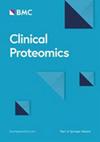Quantification of putative ovarian cancer serum protein biomarkers using a multiplexed targeted mass spectrometry assay
IF 3.3
3区 医学
Q2 BIOCHEMICAL RESEARCH METHODS
引用次数: 0
Abstract
Ovarian cancer is the most lethal gynecologic malignancy in women, and high-grade serous ovarian cancer (HGSOC) is the most common subtype. Currently, no clinical test has been approved by the FDA to screen the general population for ovarian cancer. This underscores the critical need for the development of a robust methodology combined with novel technology to detect diagnostic biomarkers for HGSOC in the sera of women. Targeted mass spectrometry (MS) can be used to identify and quantify specific peptides/proteins in complex biological samples with high accuracy, sensitivity, and reproducibility. In this study, we sought to develop and conduct analytical validation of a multiplexed Tier 2 targeted MS parallel reaction monitoring (PRM) assay for the relative quantification of 23 putative ovarian cancer protein biomarkers in sera. To develop a PRM method for our target peptides in sera, we followed nationally recognized consensus guidelines for validating fit-for-purpose Tier 2 targeted MS assays. The endogenous target peptide concentrations were calculated using the calibration curves in serum for each target peptide. Receiver operating characteristic (ROC) curves were analyzed to evaluate the diagnostic performance of the biomarker candidates. We describe an effort to develop and analytically validate a multiplexed Tier 2 targeted PRM MS assay to quantify candidate ovarian cancer protein biomarkers in sera. Among the 64 peptides corresponding to 23 proteins in our PRM assay, 24 peptides corresponding to 16 proteins passed the assay validation acceptability criteria. A total of 6 of these peptides from insulin-like growth factor-binding protein 2 (IBP2), sex hormone-binding globulin (SHBG), and TIMP metalloproteinase inhibitor 1 (TIMP1) were quantified in sera from a cohort of 69 patients with early-stage HGSOC, late-stage HGSOC, benign ovarian conditions, and healthy (non-cancer) controls. Confirming the results from previously published studies using orthogonal analytical approaches, IBP2 was identified as a diagnostic biomarker candidate based on its significantly increased abundance in the late-stage HGSOC patient sera compared to the healthy controls and patients with benign ovarian conditions. A multiplexed targeted PRM MS assay was applied to detect candidate diagnostic biomarkers in HGSOC sera. To evaluate the clinical utility of the IBP2 PRM assay for HGSOC detection, further studies need to be performed using a larger patient cohort.利用多重靶向质谱测定法定量推定的卵巢癌血清蛋白生物标记物
卵巢癌是女性最致命的妇科恶性肿瘤,高级别浆液性卵巢癌(HGSOC)是最常见的亚型。目前,美国食品及药物管理局尚未批准任何临床检验用于筛查普通人群中的卵巢癌。这突出表明,亟需开发一种结合新型技术的可靠方法,以检测妇女血清中的 HGSOC 诊断生物标志物。靶向质谱(MS)可用于识别和量化复杂生物样本中的特定肽/蛋白质,具有高准确性、高灵敏度和高重现性。在本研究中,我们试图开发一种多路复用二级靶向质谱平行反应监测(PRM)测定法,并对其进行分析验证,以相对定量血清中 23 种推测的卵巢癌蛋白质生物标记物。为了开发针对血清中目标肽的 PRM 方法,我们遵循了国家认可的共识指南,用于验证适合目的的 2 级靶向 MS 检测方法。利用每种目标肽在血清中的校准曲线计算内源性目标肽浓度。通过分析接收者操作特征曲线 (ROC) 来评估候选生物标记物的诊断性能。我们描述了开发和分析验证复用二级靶向 PRM MS 检测法的工作,该检测法用于量化血清中的候选卵巢癌蛋白生物标记物。在我们的 PRM 检测中,对应 23 种蛋白质的 64 种肽段中,对应 16 种蛋白质的 24 种肽段通过了检测验证的可接受性标准。在一组 69 位早期 HGSOC 患者、晚期 HGSOC 患者、良性卵巢疾病患者和健康(非癌症)对照组的血清中,共定量分析了其中 6 种肽,它们分别来自胰岛素样生长因子结合蛋白 2(IBP2)、性激素结合球蛋白(SHBG)和 TIMP 金属蛋白酶抑制剂 1(TIMP1)。与健康对照组和良性卵巢疾病患者相比,IBP2 在晚期 HGSOC 患者血清中的丰度显著增加,因此被确定为候选诊断生物标记物。应用多重靶向 PRM MS 分析检测 HGSOC 血清中的候选诊断生物标记物。要评估 IBP2 PRM 检测法在 HGSOC 检测中的临床实用性,还需要使用更大的患者群开展进一步的研究。
本文章由计算机程序翻译,如有差异,请以英文原文为准。
求助全文
约1分钟内获得全文
求助全文
来源期刊

Clinical proteomics
BIOCHEMICAL RESEARCH METHODS-
CiteScore
5.80
自引率
2.60%
发文量
37
审稿时长
17 weeks
期刊介绍:
Clinical Proteomics encompasses all aspects of translational proteomics. Special emphasis will be placed on the application of proteomic technology to all aspects of clinical research and molecular medicine. The journal is committed to rapid scientific review and timely publication of submitted manuscripts.
 求助内容:
求助内容: 应助结果提醒方式:
应助结果提醒方式:


